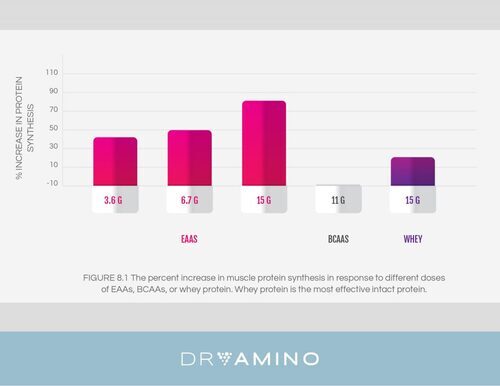We can see how the increase in muscle protein synthesis is more responsive to essential amino acids. The ratios of essential amino acids in amino acid powders can also be optimized. A properly formulated essential amino acid supplement can be three times as effective as a whey protein powder supplement.
While essential amino acids are more potent than whey protein, there are advantages to combining aminos with whey as part of a muscle-building amino acid powder supplement. Whey protein is digested over a longer time frame than free-form essential amino acids, and (as far as intact proteins go), has a good balance of essential amino acids (about 45% of the total). When you consume whey protein with essential amino acids you prolong the beneficial effects of the aminos. So, while amino acids are the victor in the amino acids vs. protein powder debate, it’s not really an either/or situation. Whey protein and amino acids can work synergistically to produce superior results.
A Word of Caution on the Labeling of Protein Supplement Products
The discerning customer knows what he or she wants, but the information provided about a product is often limited to the label on the package. Unfortunately, labels can range from uninformative to downright deceptive. For example, it is not unusual for “pure whey protein” to contain as little as 60% of calories as whey protein, with the balance of calories being comprised of carbohydrate and fat. The lesson is this: Buyer beware! Don’t just buy on the basis of product name. Dig deep into what the product actually provides.
Another labeling issue of considerable concern is how to figure out the relative proportions of different proteins in a protein mixture. Most supplements include some whey protein, as it is widely accepted as one of the highest quality proteins. However, because of cost and certain characteristics, other proteins are often included, such as soy and collagen. Labeling rarely includes the proportion of each protein. Consequently, the true protein quality of some supplements is uncertain. Ingredients are listed in order of descending quantity, so the first ingredient listed is ideally a high-quality protein such as whey.
Finally, it is the right of consumers to get what the product promises. Often, this is not the case. Spot-checking of nutritional supplements has revealed that the actual contents do not always match the labelling. There can be ingredients lurking in protein supplement products that aren’t even listed on the label. For this reason, it is advisable to only buy supplements whose contents have been certified by an independent source, such as US Pharmacopeia, or to at least check the website of the producer to determine if they have the appropriate certifications. This issue is of particular concern for athletes who could be unwittingly consuming banned substances. Numerous cases of positive tests for banned substances have occurred because an ingredient was included in a supplement but not mentioned in the packaging. Although the industry has been making progress in cleaning up this problem, it still persists. Protein supplements are not regulated by the Food and Drug Administration, so the responsibility falls on the consumer to deal only with reputable suppliers.
#DrRobertWolfe











